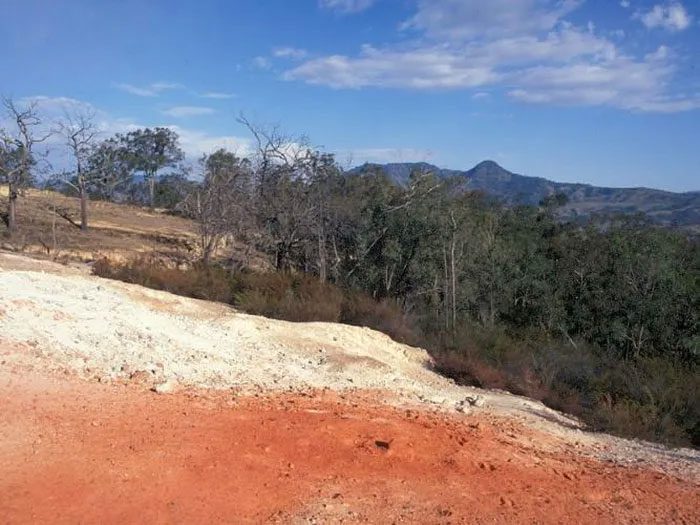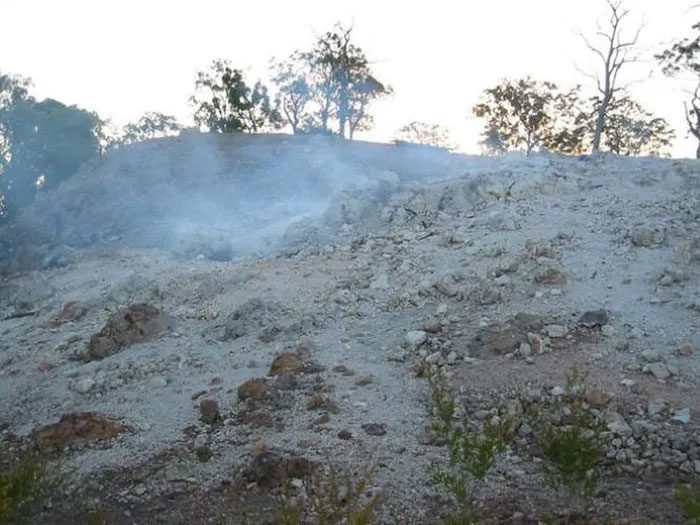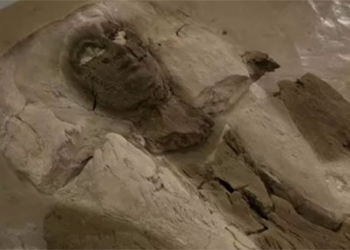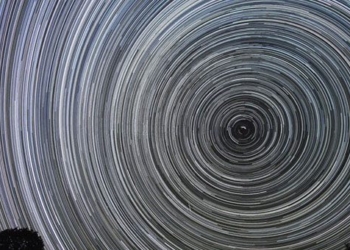Located in New South Wales, Australia, 224 kilometers north of Sydney, a coal seam extending 30 meters deep within Wingen Mountain has been smoldering for 6,000 years.
For this reason, the area is famously nicknamed Burning Mountain.
The Fire Deep Within the Mountain

Burning Mountain has become barren due to the underground fire burning for 6,000 years.
Coal seams are common on Earth. It is estimated that around 1,000 coal seams are currently producing smoldering fires, particularly in countries rich in coal resources. In fact, many coal seam fires have been recorded in India, China, and the United States, often due to human intervention such as coal mining. Most of these coal seams only burn for a few days, or at most, a few months.
However, this is not always the case. For example, the Jharia coal mine in India has been burning continuously for over 100 years. Nevertheless, it pales in comparison to the seam in Wingen Mountain, also known as Burning Mountain, Australia, which has been smoldering for 6,000 years. Burning Mountain is home to the only natural coal fire in Australia and is also the oldest coal mine in the world.
According to local legend, the word “wingen” means “fire.” In ancient times, the Gumaroi people from the north of the Liverpool Range in Australia sent a group to the south to capture women from the Wanaruah tribe, who lived near Burning Mountain, to take as wives.
Warned by another tribe, the Wanaruah warriors bravely confronted the enemy while their wives quietly hid behind the mountain’s edge. After the battle, many husbands never returned.
Overcome with grief, one wife prayed to Biami, the sky god, to allow her to die alongside her husband. Heeding her plea, Biami transformed her into stone. Her tears turned into fire and continuously burned within the mountain, leading to its name, Wingen, meaning Burning Mountain.
Scientists once believed that the activity of Burning Mountain was a sign of volcanic activity. It wasn’t until 1829 that geologist Reverend C.P.N Wilton determined it was a fire from underground coal 30 meters deep within Wingen Mountain. This coal mine has been sustaining the smoldering fire for thousands of years.
No one knows exactly how the fire started, but scientists believe it may have been ignited by a lightning strike or a forest fire. There is also a hypothesis that it originated from a fire set by Indigenous people in ancient times.
Alternatively, the fire could have self-ignited. This process occurs when the coal seam is exposed to air, creating a reaction with oxygen that causes it to spontaneously combust. This is entirely possible since the self-heating temperature of coal ranges from 35 to 140 degrees Celsius.
Since its emergence 6,000 years ago, the fire at Burning Mountain has moved 6 kilometers. It is estimated that it spreads 1 meter each year. At this rate, the fire will “attack” the suburbs of Sydney in about 255,000 years.

Smoke from the underground fire releases many harmful gases into the environment.
A Barren Tourist Destination
According to geologists, such underground fires do not burn in large flames but accumulate over long periods, similar to a wood-burning stove. The slow-burning process causes the soil at Burning Mountain to have uneven colors.
In areas where the fire has been active for a long time, the soil becomes bleached, and the surface is uneven. Every day, this site emits a massive amount of CO2 into the atmosphere. Consequently, the vegetation around this area is also affected, becoming barren and desolate.
Humans will not be able to see the fire directly. If visitors come here, they will only see the only evidence of its existence is smoke and white ash. The ground feels warm to the touch, rocks change color to yellow and red, accompanied by a sulfuric smell released as the fire below smolders, burning the mountain’s minerals.
Mr. Guillermo Rein, Professor of Fire Science at Imperial College London, UK, states: No one knows the exact scale of the fire at Burning Mountain; we can only estimate and infer. We predict it is a sphere with a diameter of 5 to 10 meters, reaching temperatures up to 1,000 degrees Celsius.
A curious question remains: how long will Burning Mountain continue to burn? Currently, there is no answer to this question as scientists have not been able to calculate the exact size of the coal seam within Burning Mountain or how it will continue to move. It is important to note that this fire cannot be extinguished as it has been burning for thousands of years without human intervention.
The fire causes the mountain to crack, allowing oxygen to come into direct contact with the coal seam, enabling the fire to spread. Thus, Burning Mountain creates its own “chimney” and supplies oxygen for itself. Coal seam fires are notoriously difficult to extinguish, requiring tons of water and liquid nitrogen.
Moreover, many are concerned that this fire could pose serious dangers to the environment, human health, and safety. Coal seam fires can destroy the environment by releasing large amounts of CO2, methane, and other pollutants such as mercury, contributing to the greenhouse effect.
Burning Mountain is the only natural coal fire in Australia. However, it is just one of thousands of coal fires worldwide, some of which cause even more trouble. According to a 2009 study published by the United States Geological Survey (USGS), these uncontrolled fires release toxic air pollutants and cost the U.S. over one billion USD in remediation projects, with about 90% of the costs attributed to Pennsylvania and West Virginia.
While the fire at Burning Mountain has natural causes, some other coal fires have ignited due to human activities. For example, the fire in Centralia, Pennsylvania, has existed for over half a century after the city burned a landfill and likely ignited an underground fire. This area is known for its active coal fire, listed among the most dangerous places on the planet. The fire in Centralia continues to spread, with temperatures reaching up to 540 degrees Celsius, accompanied by toxic gases such as carbon monoxide and sulfur dioxide. Some of the hundreds of coal fires in China have formed over a century ago and consume a total of up to 18 million tons of coal each year.
Therefore, scientists are concerned that the level of danger in Centralia could be repeated in Sydney if the coal seam at Burning Mountain spreads to this area, although such a disaster is unlikely to occur overnight.
Despite its barren appearance, Burning Mountain remains a tourist attraction. Every year, thousands flock here to witness the world’s oldest smoldering fire.




















































